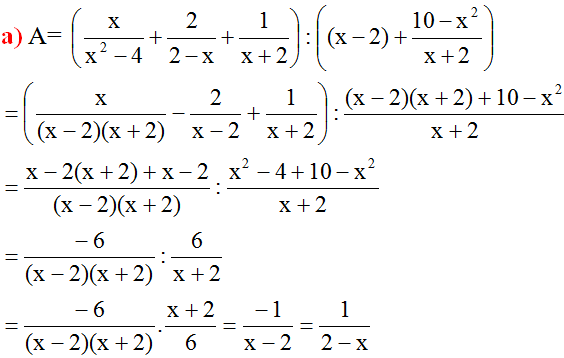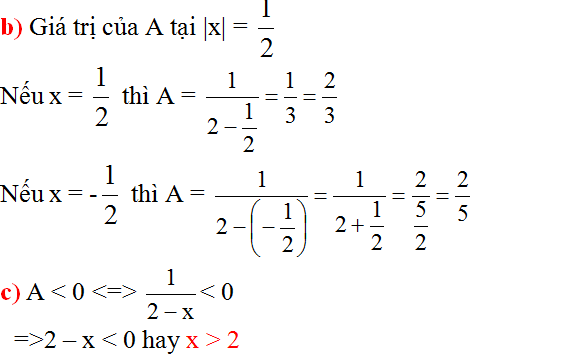Hãy nhập câu hỏi của bạn vào đây, nếu là tài khoản VIP, bạn sẽ được ưu tiên trả lời.

Lời giải của bạn Nhật Linh đúng rồi, tuy nhiên cần thêm điều kiện để A có nghĩa: \(x\ne\pm2\)

a: \(B=\left(\dfrac{21}{\left(x-3\right)\left(x+3\right)}+\dfrac{x^2-x-12}{\left(x-3\right)\left(x+3\right)}-\dfrac{x^2-4x+3}{\left(x-3\right)\left(x+3\right)}\right):\dfrac{x+3-1}{x+3}\)
\(=\dfrac{21+x^2-x-12-x^2+4x-3}{\left(x-3\right)\left(x+3\right)}:\dfrac{x+2}{x+3}\)
\(=\dfrac{3x+6}{\left(x-3\right)\left(x+3\right)}\cdot\dfrac{x+3}{x+2}=\dfrac{3}{x-3}\)
b: Ta có: |2x+1|=5
=>2x+1=5 hoặc 2x+1=-5
=>2x=4 hoặc 2x=-6
=>x=2
Thay x=2 vào B, ta được:
\(B=\dfrac{3}{2-3}=\dfrac{3}{-1}=-3\)
d: Để B<0 thì x-3<0
hay x<3

Câu 1:
a: ĐKXĐ: \(x\notin\left\{0;1;\dfrac{1}{2}\right\}\)
\(B=\dfrac{x^2+x}{x^2+x+1}-\dfrac{2x^3+x^2-x-2x^3+2-x^2-x-1}{\left(x-1\right)\left(x^2+x+1\right)}\cdot\dfrac{-x\left(x-1\right)}{2x-1}\)
\(=\dfrac{x\left(x+1\right)}{x^2+x+1}-\dfrac{-2x+1}{\left(x-1\right)\left(x^2+x+1\right)}\cdot\dfrac{-x\left(x-1\right)}{2x-1}\)
\(=\dfrac{x\left(x+1\right)}{x^2+x+1}+\dfrac{2x-1}{\left(x-1\right)\left(x^2+x+1\right)}\cdot\dfrac{-x\left(x-1\right)}{2x-1}\)
\(=\dfrac{x\left(x+1\right)}{x^2+x+1}+\dfrac{-x}{x^2+x+1}=\dfrac{x^2}{x^2+x+1}\)
b: Để \(B=\dfrac{4}{3}\) thì \(\dfrac{x^2}{x^2+x+1}=\dfrac{4}{3}\)
\(\Leftrightarrow4x^2+4x+4-3x^2=0\)
=>x=-2(nhận)

1.
a) \(x\left(x+4\right)+x+4=0\)
\(\Leftrightarrow\left(x+1\right)\left(x+4\right)=0\)
\(\Leftrightarrow\left[{}\begin{matrix}x+4=0\\x+1=0\end{matrix}\right.\Rightarrow\left[{}\begin{matrix}x=-4\\x=-1\end{matrix}\right.\)
b) \(x\left(x-3\right)+2x-6=0\)
\(\Leftrightarrow\left(x+2\right)\left(x-3\right)=0\)
\(\Leftrightarrow\left[{}\begin{matrix}x+2=0\\x-3=0\end{matrix}\right.\Rightarrow\left[{}\begin{matrix}x=-2\\x=3\end{matrix}\right.\)
Bài 1:
a, \(x\left(x+4\right)+x+4=0\)
\(\Leftrightarrow x\left(x+4\right)+\left(x+4\right)=0\)
\(\Leftrightarrow\left(x+4\right)\left(x+1\right)=0\)
\(\Leftrightarrow\left[{}\begin{matrix}x+4=0\\x+1=0\end{matrix}\right.\Leftrightarrow\left[{}\begin{matrix}x=-4\\x=-1\end{matrix}\right.\)
Vậy \(x=-4\) hoặc \(x=-1\)
b, \(x\left(x-3\right)+2x-6=0\)
\(\Leftrightarrow x\left(x-3\right)+2\left(x-3\right)=0\)
\(\Leftrightarrow\left(x-3\right)\left(x+2\right)=0\)
\(\Leftrightarrow\left[{}\begin{matrix}x-3=0\\x+2=0\end{matrix}\right.\Leftrightarrow\left[{}\begin{matrix}x=3\\x=-2\end{matrix}\right.\)
Vậy \(x=3\) hoặc \(x=-2\)

1/ a, \(A=\dfrac{3}{2x+6}-\dfrac{x-6}{2x^2+6x}\)
\(=\dfrac{3}{2\left(x+3\right)}-\dfrac{x-6}{2x\left(x+3\right)}\)
\(=\dfrac{3x-x+6}{2x\left(x+3\right)}\)
\(=\dfrac{2x+6}{2x\left(x+3\right)}\)
\(=\dfrac{2\left(x+3\right)}{2x\left(x+3\right)}\)
\(=\dfrac{1}{x}\)
Vậy \(A=x\)
b/ Khi \(x=\dfrac{1}{2}\Leftrightarrow A=\dfrac{1}{\dfrac{1}{2}}=2\)
Vậy...
2/a,
\(A=\dfrac{5x+2}{3x^2+2x}+\dfrac{-2}{3x+2}\)
\(=\dfrac{5x+2}{x\left(3x+2\right)}-\dfrac{2x}{x\left(3x+2\right)}\)
\(=\dfrac{5x+2-2x}{x\left(3x+2\right)}\)
\(=\dfrac{3x+2}{x\left(3x+2\right)}\)
\(=\dfrac{1}{x}\)
Vậy....
b/ Với \(x=\dfrac{1}{3}\Leftrightarrow A=\dfrac{1}{\dfrac{1}{3}}=3\)
Vậy..

a) \(A = \frac{2x^2 - 16x+43}{x^2-8x+22}\) = \(\frac{2(x^2-8x+22)-1}{x^2-8x+22}\) = \(2 - \frac{1}{x^2-8x+22}\)
Ta có : \(x^2-8x+22 \) = \(x^2-8x+16+6 = ( x-4)^2 +6 \)
Vì \((x-4)^2 \ge 0 \) với \( \forall x\in R\) Nên \(( x-4)^2 +6 \ge 6 \)
\(\Rightarrow \) \(x^2-8x+22 \) \( \ge 6\)\(\Rightarrow \) \(\frac{1}{x^2-8x+22} \) \(\le \frac{1}{6}\) \(\Rightarrow \) - \(\frac{1}{x^2-8x+22} \) \(\ge - \frac{1}{6}\)
\(\Rightarrow \) A = \(2 - \frac{1}{x^2-8x+22}\) \( \ge 2-\frac{1}{6}\) = \(\frac{11}{6}\) Dấu "=" xảy ra khi và chỉ khi x=4
Vậy GTNN của A = \(\frac{11}{6}\) khi và chỉ khi x=4

\(1.\)
\(a.\)
\(\dfrac{8}{\left(x^2+3\right)\left(x^2-1\right)}+\dfrac{2}{x^2+3}+\dfrac{1}{x+1}\)
\(=\dfrac{8}{\left(x^2+3\right)\left(x^2-1\right)}+\dfrac{2\left(x^2-1\right)}{\left(x^2+3\right)\left(x^2-1\right)}+\dfrac{1\left(x-1\right)\left(x^2+3\right)}{\left(x^2-1\right)\left(x^2+3\right)}\)
\(=\dfrac{8}{\left(x^2+3\right)\left(x^2-1\right)}+\dfrac{2x^2-2}{\left(x^2+3\right)\left(x^2-1\right)}+\dfrac{x^3-x^2+3x-3}{\left(x^2-1\right)\left(x^2+3\right)}\)
\(=\dfrac{8+2x^2-2+x^3-x^2+3x-3}{\left(x^2+3\right)\left(x^2-1\right)}\)
\(=\dfrac{x^3+x^2+3x+3}{\left(x^2+3\right)\left(x^2-1\right)}\)
\(=\dfrac{x^2\left(x+1\right)+3\left(x+1\right)}{\left(x^2+3\right)\left(x^2-1\right)}\)
\(=\dfrac{\left(x^2+3\right)\left(x+1\right)}{\left(x^2+3\right)\left(x^2-1\right)}\)
\(=x-1\)
\(b.\)
\(\dfrac{x+y}{2\left(x-y\right)}-\dfrac{x-y}{2\left(x+y\right)}+\dfrac{2y^2}{x^2-y^2}\)
\(=\dfrac{x+y}{2\left(x-y\right)}-\dfrac{x-y}{2\left(x+y\right)}+\dfrac{2y^2}{\left(x-y\right)\left(x+y\right)}\)
\(=\dfrac{\left(x+y\right)^2}{2\left(x^2-y^2\right)}-\dfrac{\left(x-y\right)^2}{2\left(x^2-y^2\right)}+\dfrac{4y^2}{2\left(x^2-y^2\right)}\)
\(=\dfrac{x^2+2xy+y^2}{2\left(x^2-y^2\right)}-\dfrac{x^2-2xy+y^2}{2\left(x^2-y^2\right)}+\dfrac{4y^2}{2\left(x^2-y^2\right)}\)
\(=\dfrac{x^2+2xy+y^2-x^2+2xy-y^2+4y^2}{2\left(x^2-y^2\right)}\)
\(=\dfrac{4xy+4y^2}{2\left(x^2-y^2\right)}\)
\(=\dfrac{4y\left(x+y\right)}{2\left(x^2-y^2\right)}\)
\(=\dfrac{2y}{\left(x-y\right)}\)
Tương tự các câu còn lại





`a,` Với `x=3`
\(B=\dfrac{x^2-x}{2x+1}\\ \Rightarrow\dfrac{3^2-3}{2\cdot3+1}\\ =\dfrac{9-3}{6+1}\\ =\dfrac{6}{7}\)
`b,` Ta có `M=A*B`
\(M=\left(\dfrac{1}{x-1}+\dfrac{x}{x^2-1}\right)\cdot\dfrac{x^2-x}{2x+1}\\ =\left(\dfrac{1}{x-1}+\dfrac{x}{\left(x-1\right)\left(x+1\right)}\right)\cdot\dfrac{x\left(x-1\right)}{2x+\text{ }1}\\ =\left(\dfrac{x+1}{\left(x-1\right)\left(x+1\right)}+\dfrac{x}{\left(x-1\right)\left(x+1\right)}\right)\cdot\dfrac{x\left(x-1\right)}{2x+1}\\ =\dfrac{x+1+x}{\left(x-1\right)\left(x+1\right)}\cdot\dfrac{x\left(x-1\right)}{2x+1}\\ =\dfrac{2x+1}{\left(x-1\right)\left(x+1\right)}\cdot\dfrac{x\left(x-1\right)}{2x+1}\\ =\dfrac{x}{x+1}\)
`c,` Để `M=1/2`
`=> x/(x+1)=1/3`
`<=> (3x)/(3(x+1))= (x+1)/(3(x+1))`
`<=> 3x=x+1`
`<=>3x-x=1`
`<=>2x=1`
`<=>x=1/2`
các học bá đâu rùi